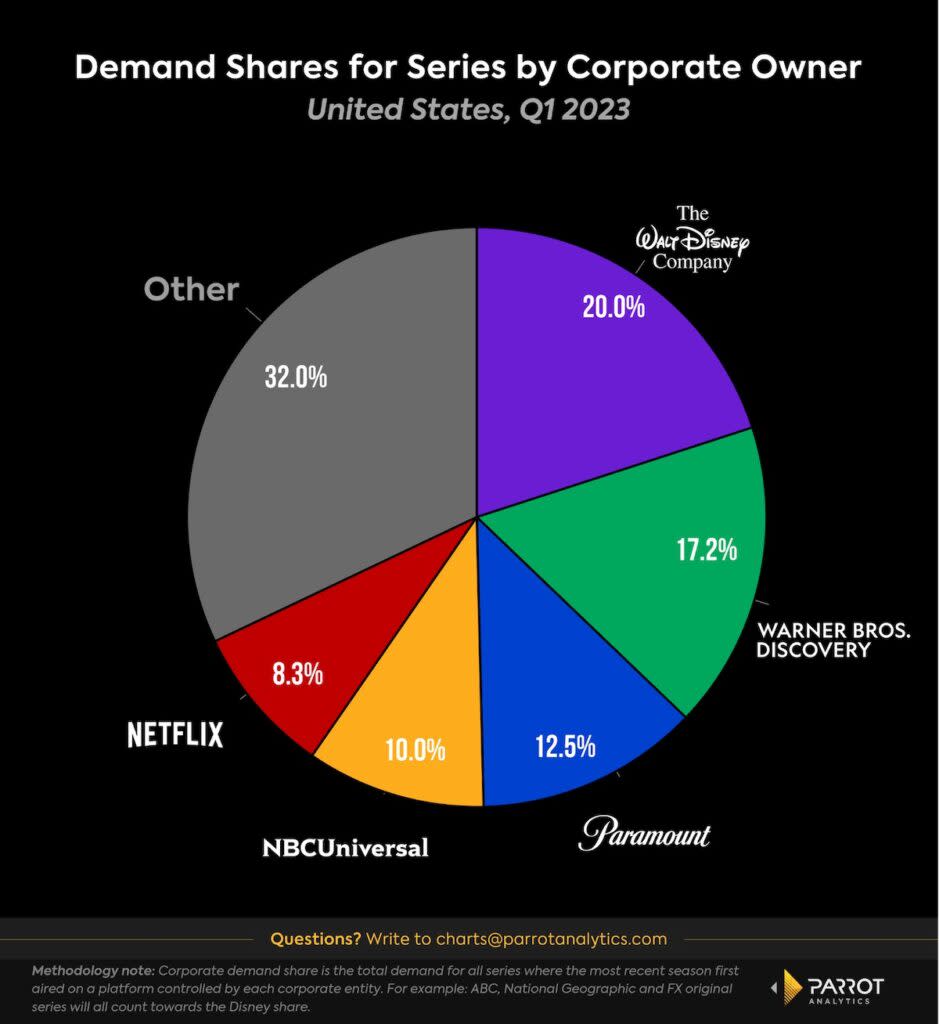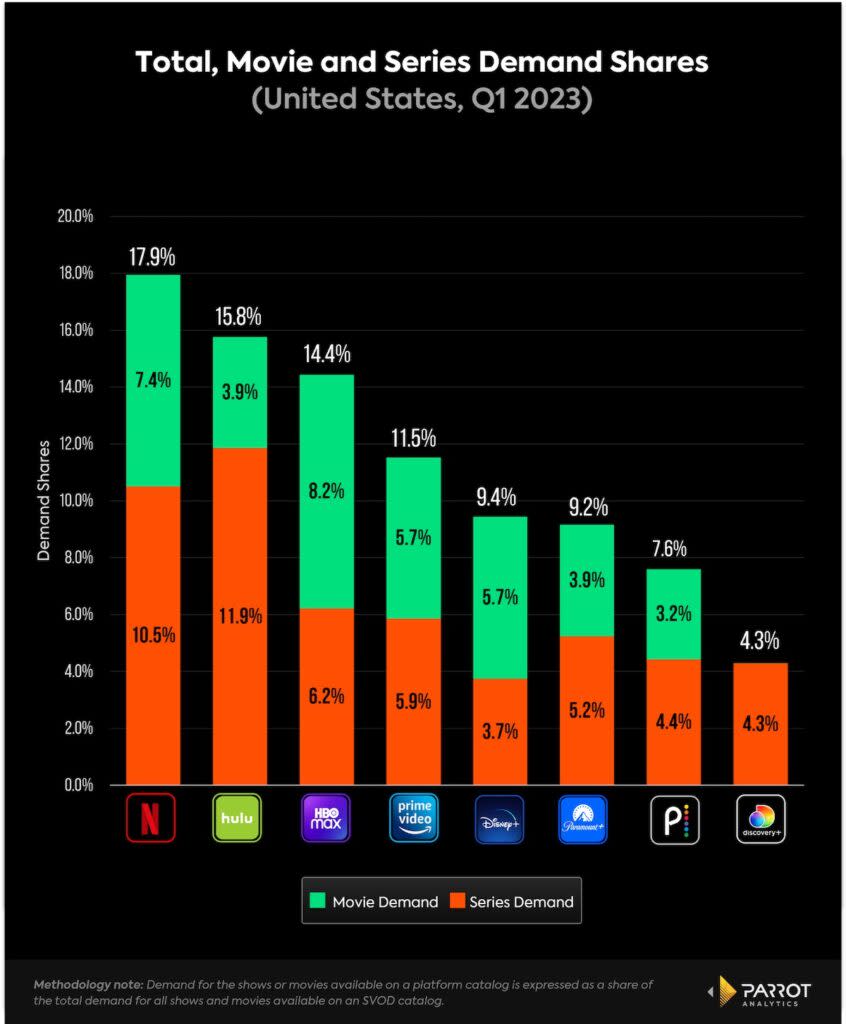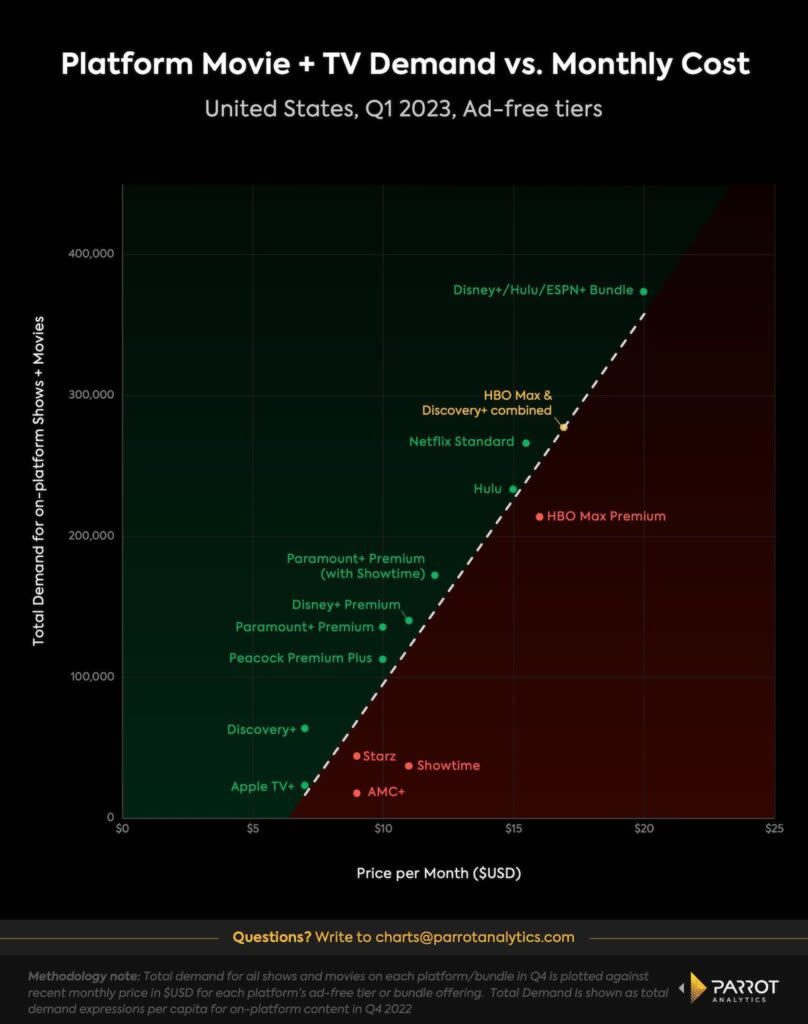Demand for a Combined Disney+ and Hulu Offering Would Easily Top Netflix | Charts
Disney stock has slipped 12% since it reported earnings last week — another 2% on Tuesday alone. The first-ever quarterly subscriber loss at Disney+, when analysts had expected at least a small amount of growth, didn’t reassure investors, even if Disney was showing it could get more revenue per customer.
Returning CEO Bob Iger is faced with complex challenges on multiple fronts. Disney must continue boosting the ad-supported tier of Disney+ to reignite subscription growth and alternative revenue sources, wrestle with disappointed Disney+ Hotstar users in the high-upside Asia Pacific region and determine a future course of action with Hulu. At the same time, Iger must reestablish strong theatrical windows to maximize revenue, stave off the ongoing decline of linear television and hope the ongoing writers’ strike ends before impacting its content pipeline following massive disruption from the early pandemic. No one ever said Hollywood was easy.
The announcement that Disney will begin making Hulu content available on Disney+ in a combined app later this year seems to be an acknowledgement that the family-friendly franchise power of Disney+ may need an assist from more expansive programming. On the bright side, however, is the fact that Disney owns 23 of the 25 most in-demand series on Disney+ in the first quarter of 2023, representing an advantage over rivals both in original development and prospective licensing opportunities moving forward. Conversely, fewer than 10 of the 25 most in-demand series on Hulu last quarter were owned in-house, adding another layer to the debate about keeping or selling the streamer.

Disney remains the leader at the corporate level in terms of demand for its series, according to Parrot Analytics‘ data, which takes into account consumer research, streaming, downloads and social media, among other engagement. Corporate demand share can assess which companies have the most valuable content to exploit, either through streaming subscriptions or licensing.
Shows that originated on a Disney-owned channel or service accounted for a fifth of all demand for series in the U.S. in the first quarter of 2023, reflecting a deep library of resonant content across the company’s linear and streaming portfolios. Translating the company’s leading corporate demand share to streaming dominance will be a key problem for Iger to solve.
Also Read:
Disney CEO Bob Iger Is Open to Selling Hulu – But Finding a Buyer Will Be a Challenge | Analysis
Despite its dependence on licensed shows, Hulu stands out as a competitive strength for Disney. In the first quarter, Hulu had the second-largest demand for the shows and movies it carries, with 15.8% market share. Disney+ ranked fifth with 9.4%. Taken together, the Disney+-Hulu bundle is a formidable juggernaut that easily surpasses Netflix as the top streaming destination in terms of demand for content.

It is also worth noting that despite a smaller movie library than many of its rival streamers, Disney+ is tied for third in total movie demand (5.7%) behind just Netflix (7.4%) and HBO Max (8.2%). This speaks to the power of Disney’s established film brands such as Marvel, Star Wars and Pixar. We can expect the looming arrival of hit blockbuster “Avatar: The Way of Water” to also generate additional interest in the streamer’s film catalog.
Disney+’s strength in movies is complementary to Hulu’s strength in TV series. Hulu had the largest demand for its series across all SVODs in the U.S. Another dimension in which these two streaming services are well matched is the demographics of the audiences they appeal to. When we last considered the path forward for Disney and Hulu, we noted how the demographics of original content on both services are complementary. While the action-heavy slate of Marvel and Star Wars series from Disney+ has a younger and more male-skewing audience, Hulu’s dramas tend to appeal to an older and more female audience.

Last Wednesday, the company also announced it would increased the price of its ad-free service later this year, in line with price increases we have seen from its rivals. Compared to the ad-free plans of competitors, the amount of demand for content on Disney+ looks attractively priced for consumers at the current price point ($10.99/mo). This means that the streamer has some room to raise prices without significantly denting its competitiveness in the eyes of consumers. The addition of content from Hulu should also help to soften the blow of future price increases for subscribers.
Disney is juggling multiple priorities here. It is clearly still figuring out how to balance Hulu and Disney+, what the role of each service is, how they relate to each other, and what the ownership of Hulu will be in the future. The market’s reaction to the company’s quarterly financials is a reminder that the company must manage subscriber churn while increasing its ARPU through not-too-jarring price increases. Iger’s familiar leadership is looking like a welcome and stabilizing force for these tumultuous times.
Christofer Hamilton is a senior insights analyst at Parrot Analytics, a WrapPRO partner. For more from Parrot Analytics, visit the Data and Analysis Hub.
Also Read:
How the Streamers Stack Up Right Now in Subscribers and Revenue | Charts

